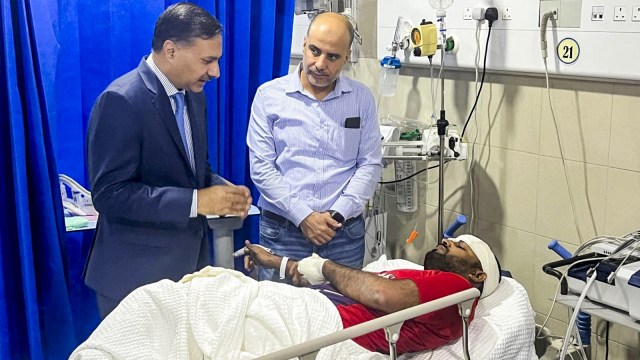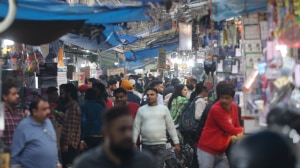Carpenters, masons, domestic workers, fabricators, drivers and even food delivery riders and courier delivery boys — to a very large extent, Kuwait depends on the Indian workforce.
With a million-strong diaspora and the largest expatriate community in Kuwait, Indians constitute 21 per cent of Kuwait’s total population and 30 per cent of its total workforce.

According to the latest statistics released by the Public Authority for Civil Information (PACI) of Kuwait, the population of Kuwait was 4.859 million (1.546 million citizens and 3.3 million expatriates) as of December 2023. Of this, labourers and workers comprised 61 per cent of the total population (almost three million) and 75 per cent of the country’s total expat population. The Indian community remains the largest expatriate community in Kuwait and has already crossed the one million mark.
Often living in harsh conditions — cramped rooms in semi-constructed buildings or in labour camps like the one in Mangaf gutted Wednesday — many opt for Gulf countries not only because of the high demand for unskilled Indian workers, but because the earnings are significantly higher than that at home in India.
Several studies on labour migration to the Gulf region have indicated that Indian workers, even those belonging to the low-skilled category, earn higher wages if they have relevant experience in the domestic labour market.
 Smoke billows after a fire broke out in a building, in Mangaf, Kuwait, Wednesday, June 12, 2024. At least 41 people were killed, according to officials. (PTI Photo)
Smoke billows after a fire broke out in a building, in Mangaf, Kuwait, Wednesday, June 12, 2024. At least 41 people were killed, according to officials. (PTI Photo)
According to International Labour Organisation regulations, the minimum referral wages (MRW) have been arrived at for Indian labourers engaged abroad, many among those employed in the six Gulf countries – Kuwait, United Arab Emirates, Oman, Qatar, Saudi Arabia and Bahrain.
For Kuwait, the Indian government, in conjunction with states where they travel from (mostly Kerala, Tamil Nadu, Andhra Pradesh and Punjab), fixed that in the range of $300-1,050 in 2016 across 64 categories of work.
Story continues below this ad
In the Gulf, MRW in Oman and Qatar are slightly better than what is being offered in Kuwait – when compared to other Asian countries like Indonesia ($203), Malaysia ($231-358) and Iraq ($345-600), the wages in Kuwait may be much higher.
But to be covered by MRW, Indian workers have to register with the Ministry of External Affairs’ eMigrate portal and travel under the terms and conditions of the respective labour mobility agreements of various countries. These rates are generally advised by Indian missions in destination countries, considering aspects like the prevailing cost of living in the country and the wage rates prescribed by the relevant ministries in their respective country.
For instance, in Kuwait, carpenters, masons, drivers and pipefitters come in the minimal category of $300 a month, while heavy vehicle drivers and domestic workers fare slightly better.
In a reply to Parliament in December 2022, then Minister of State, MEA, V Muraleedharan had said that MRW for employment in six Gulf countries were adjusted downwards due to the Covid situation, “to protect our employment in the Gulf”. However, by 2022, it returned to the same level as it was in 2019-20.
Story continues below this ad
He had also put the number of Indian expats in Kuwait at 9.24 lakh at the time, which is now estimated to have crossed a million mark.
The MEA maintains a record of Emigration Check Required (ECR) passport category workers who migrate to the Gulf countries after obtaining clearance through the eMigrate portal.
Women below the age of 30 years are not granted emigrant clearance for employment as housemaid, domestic worker, hairdresser, beautician, dancer, stage artist, labourers, general workers.
India also offers Pravasi Bharatiya insurance policy to all Indian emigrant workers in Kuwait with a coverage of Rs 10 lakh in case of accidental deaths or permanent disability, and also bears legal expenses in case of disputes.
Story continues below this ad
According to the website of the Indian Embassy in Kuwait, the 1990-1991 Gulf War had a major impact on the Indian community in Kuwait. This led to a mass exodus of the Indian community, including evacuation of over 1.7 lakh Indians.
However, after Kuwait’s liberation, says the Embassy, most members of the Indian community gradually returned. While the Palestinians constituted the largest expatriate community in Kuwait pre-war, their numbers decreased post-war and gradually the Indian community became the largest in Kuwait.
From time to time, the Indian Embassy also issues advisories for its nationals engaged as labourers to not fall prey to discrimination, abuse or scams. In one such advisory, the Indian Embassy says that even as there are some rare cases of maltreatment and abuse faced by Indian workers in Kuwait, the working and living conditions in Kuwait (as is common with other Gulf States), are hard, particularly in summer months.



 Smoke billows after a fire broke out in a building, in Mangaf, Kuwait, Wednesday, June 12, 2024. At least 41 people were killed, according to officials. (PTI Photo)
Smoke billows after a fire broke out in a building, in Mangaf, Kuwait, Wednesday, June 12, 2024. At least 41 people were killed, according to officials. (PTI Photo)





